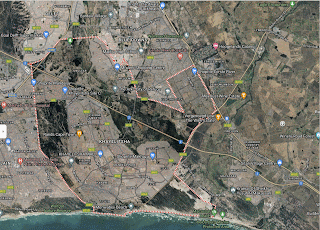Ethics in the wine industry is a continual topic, as a quick perusal of any wine industry news-site will show you (eg. Wine Industry Insight). It usually involves questioning the (lack of?) ethics of some (many?) people in the industry (especially with regard to tax compliance!). How big a difference is there between evading the law and breaking it?
I have not written much about wine-industry ethics in this blog. This is not from a lack of interest in the topic, but for lack of anything much to say that might be a bit different from any other wine blogger. However, a couple of events recently have changed that. So, here we go.
First, I was sent an email (thanks John Stallcup) drawing my attention to the blog of Scott Galloway (No Mercy / No Malice), and specifically the post on Firewater. You should check it out, as it is both interesting and very well written. The author does not shy away from ethics, or any other topic.
The second thing is that I finally made it to South Africa (see the photo above). This was fascinating, especially for me as a biologist — the plants and animals are unique, and it was great to see them in situ; and the landscape reminds me very much of my homeland (Australia). Moreover, my wife’s parents long ago worked for Svenskakyrkan (the Church of Sweden) as school teachers for the black children of what was then called Rhodesia. So, South Africa is pretty close to her original homeland, too.
What does this have to do with the wine industry? That is simple, because I have now been to wine-lands on several continents (Australia, North America, Europe, South America); and their contrast with South Africa is, in one particular way, stark.
Vineyards in Australia, for example, are nested among the bushland (as we call it), so that the backdrop is often native eucalypt trees, etc. Vineyards in northern Europe, for example, are spread along romantic rivers with scattered medieval villages. These sorts of things are part of the image that the wine industry tries to promulgate for itself; and by and large it is accurate.
However, it would be just as accurate to note, for example, that the European villages were once the home-land of abject poverty; the Middle Ages were not a time to be a poor serf — servile life was no fun, and death at a young age was rampant. The Plague (or Black Death) was not something that was easy to live through. However, we do not see any of that in the modern world, so that wine tourists can focus on the romance. Focus on enjoyment, and the quality of life, is important.
South Africa, in some ways, is another matter. Sure, there are vineyard regions that are very familiar to me from growing up in Australia, in both look and feel (although the eucalypt trees growing there are not native, but were introduced by Europeans). However, by contrast there are the vineyards around Cape Town. The massive shanty town (as an Australian would call it) south-east of Cape Town was a great shock to my bus-load of middle-class Swedish tourists. The contrast with the Kruger National Park (lions, elephants, giraffes, buffalo, etc), and the lower-middle-class servers in the tourist industry, was stark. Everyone on the bus noticed, and everyone expressed concern. Our guide, on the other hand, kept the same neutral tone as he had throughout the trip, while he explained what the government was doing about it, and planning to do.
These slums (named Khayelitsha) are possibly the third largest in the world (8 cities with the world’s largest slums), with perhaps one million residents. They are not the only slums in South Africa (List of slums in South Africa), but probably a third of Cape Town's 3.7 million residents live in its slums (The tale of two slums in South Africa). As you can imagine, Life in South African shanty towns is not easy.
The point here is that some of the vineyards of Cape Town are right next to this enormous shanty town, as shown in the photo above, and on the Google Map below (Khayelitsha is outlined, and one of the nearby vineyards is named). One cannot miss the contrast, when you are there. However you don’t see it in any of the wine-industry photos (see the second photo above).
For me, the wine industry and vineyards will never be the same again. I can no longer look at a village on the Rhine River, nested among the vineyards, without seeing life as it was in the Middle Ages, when the villages came into being. I ask myself: how ethical is it to only ever show the romance? The ethics of only showing this is one of omission, not commission — no-one is faking anything, but they sure as hell are leaving some things out.
I am also reminded of another much simpler, but equally notable, part of my own recent history. On 7 November 2023 it was 150 years since the Swedish parliament decided to formally allow women to attend the country’s universities, and this was duly noted in my local newspaper here in Uppsala. This historical event was way ahead of what happened in most other countries, which is a very positive aspect that Swedes are proud of. However, we should not ignore the fact that Sweden has some of the oldest universities in the world, with Uppsala University founded way back in 1477 and Lund University in 1666 (although it traces its roots back to 1425). So, which do we focus on — the later 150 years (with women) or the first 400 years (without women)? My argument is that, ethically, we should see both; but it seems to me that the wine industry would probably not do so.
[All of the photos above were taken by Susanne Stenlund.]





No comments:
Post a Comment